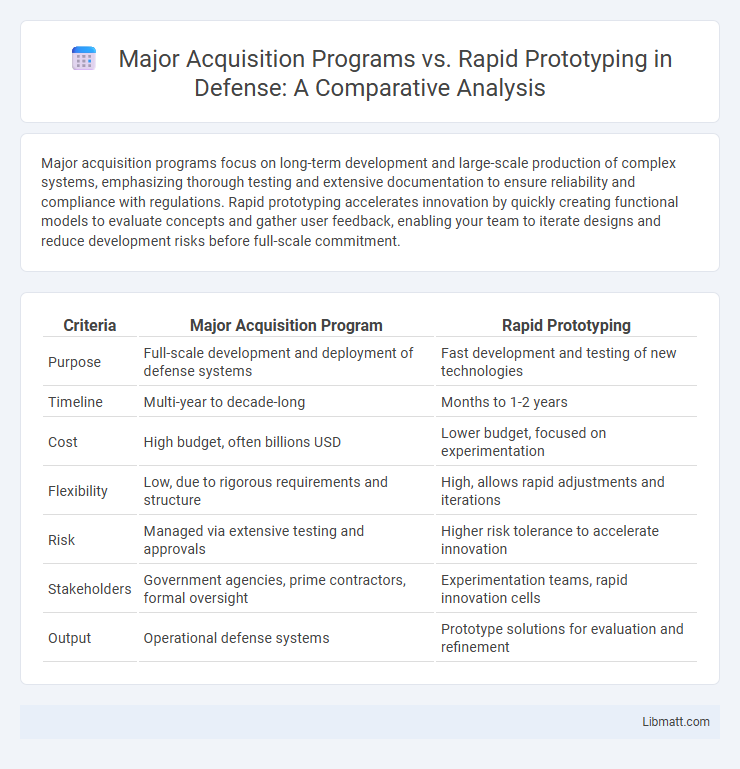Major acquisition programs focus on long-term development and large-scale production of complex systems, emphasizing thorough testing and extensive documentation to ensure reliability and compliance with regulations. Rapid prototyping accelerates innovation by quickly creating functional models to evaluate concepts and gather user feedback, enabling your team to iterate designs and reduce development risks before full-scale commitment.
Table of Comparison
| Criteria | Major Acquisition Program | Rapid Prototyping |
|---|---|---|
| Purpose | Full-scale development and deployment of defense systems | Fast development and testing of new technologies |
| Timeline | Multi-year to decade-long | Months to 1-2 years |
| Cost | High budget, often billions USD | Lower budget, focused on experimentation |
| Flexibility | Low, due to rigorous requirements and structure | High, allows rapid adjustments and iterations |
| Risk | Managed via extensive testing and approvals | Higher risk tolerance to accelerate innovation |
| Stakeholders | Government agencies, prime contractors, formal oversight | Experimentation teams, rapid innovation cells |
| Output | Operational defense systems | Prototype solutions for evaluation and refinement |
Defining Major Acquisition Programs
Major Acquisition Programs are comprehensive, structured efforts focused on developing and delivering large-scale defense systems with rigorous oversight, detailed planning, and long-term budgeting. These programs involve extensive requirements analysis, testing, and risk management to ensure system reliability and operational effectiveness. You should understand that Major Acquisition Programs contrast with Rapid Prototyping, which emphasizes speed and flexibility to quickly develop and refine capabilities.
Understanding Rapid Prototyping
Rapid prototyping accelerates product development by quickly creating functional models, enabling fast feedback and iterative improvements compared to the lengthy timelines of major acquisition programs. This approach reduces risk by allowing you to identify design flaws early and refine solutions before full-scale production. Emphasizing flexibility and speed, rapid prototyping supports innovation through continuous testing and adaptation, contrasting with the structured, resource-intensive processes typical of major acquisition programs.
Key Differences Between Acquisition Programs and Prototyping
Major acquisition programs involve structured, long-term procurement processes focused on delivering fully operational systems with extensive testing and certification. Rapid prototyping emphasizes fast, iterative development cycles to validate concepts and gather user feedback early, minimizing upfront investment and risk. Your project benefits from understanding these key differences to balance thoroughness with agility in system development.
Strategic Objectives: Long-Term vs. Short-Term Solutions
Major acquisition programs prioritize long-term solutions by focusing on comprehensive capability development, extensive testing, and sustained operational support to meet evolving defense requirements over decades. Rapid prototyping emphasizes short-term solutions by accelerating the development cycle, enabling quick experimentation and iterative design to address immediate tactical needs and rapidly changing threats. This strategic contrast highlights durability and scalability in major programs versus agility and speed in rapid prototyping methodologies.
Timeline and Development Speed
Major acquisition programs typically span several years, often exceeding a decade, due to extensive requirements gathering, testing, and validation phases. Rapid prototyping accelerates development speed by focusing on iterative design and agile methodologies, delivering functional models within months. The shorter timeline of rapid prototyping enables faster feedback loops and quicker adjustments compared to the prolonged, structured nature of major acquisition programs.
Risk Management Approaches
Major acquisition programs implement formal, structured risk management approaches involving comprehensive risk assessments, mitigation plans, and continuous monitoring to ensure compliance with regulatory standards and stakeholder requirements. Rapid prototyping employs agile risk management, emphasizing iterative testing, quick feedback loops, and adaptive responses to emerging issues to minimize development risks efficiently. Your project benefits from selecting the approach that balances thorough risk control with flexibility depending on time constraints and complexity.
Budget and Cost Implications
Major acquisition programs typically involve extensive budgets with long-term cost commitments due to rigorous testing, regulatory compliance, and full lifecycle support, often running into billions of dollars. Rapid prototyping, by contrast, emphasizes accelerated development and iterative design using lower initial investments, helping you identify potential issues early and reduce overall program risk and costs. Choosing rapid prototyping can optimize your budget allocation by minimizing expensive redesigns and fostering faster, cost-effective innovation.
Innovation and Flexibility
Rapid prototyping accelerates innovation by enabling quick iteration and real-time testing of concepts, fostering flexibility in design adjustments and stakeholder feedback. Major acquisition programs often face longer development cycles and rigid requirements, limiting adaptability but providing thorough evaluation and scalability. Emphasizing rapid prototyping enhances responsiveness to evolving technologies and operational needs, while major acquisitions prioritize comprehensive integration and long-term capability development.
Regulatory and Compliance Considerations
Major acquisition programs involve stringent regulatory and compliance requirements, including extensive documentation, formal audits, and adherence to federal acquisition regulations such as the FAR and DFARS. Rapid prototyping emphasizes flexibility but must still comply with relevant industry standards and cybersecurity policies, ensuring early-stage designs meet baseline regulatory criteria. Your project's compliance strategy should balance thorough oversight with agile development to mitigate risks and align with statutory obligations.
When to Choose Major Acquisition vs Rapid Prototyping
Major acquisition programs are best suited for complex, long-term projects requiring extensive planning, rigorous testing, and significant investment to deliver fully operational systems. Rapid prototyping excels when quick development and iterative feedback are essential to refine requirements and reduce technical risks early in the process. You should choose major acquisition for proven solutions with stable requirements and rapid prototyping when innovation speed and flexibility are crucial for evolving needs.
Major acquisition program vs Rapid prototyping Infographic

 libmatt.com
libmatt.com